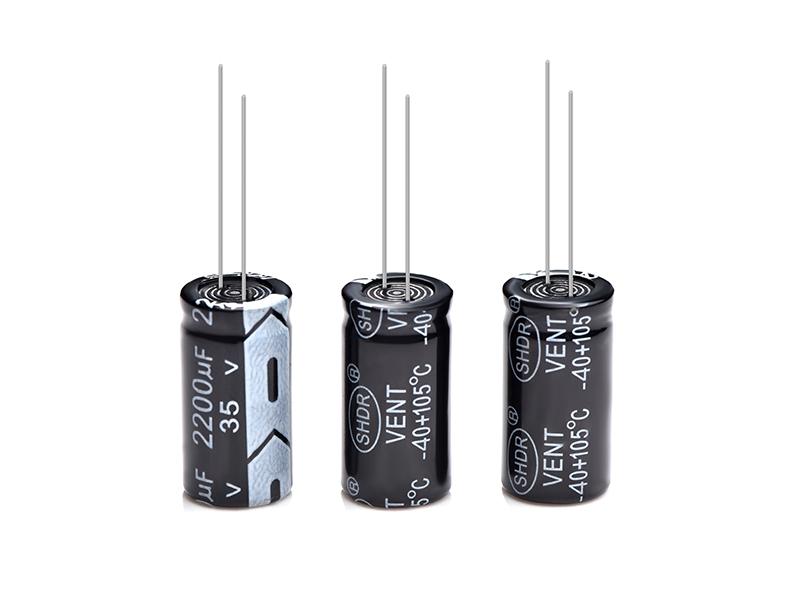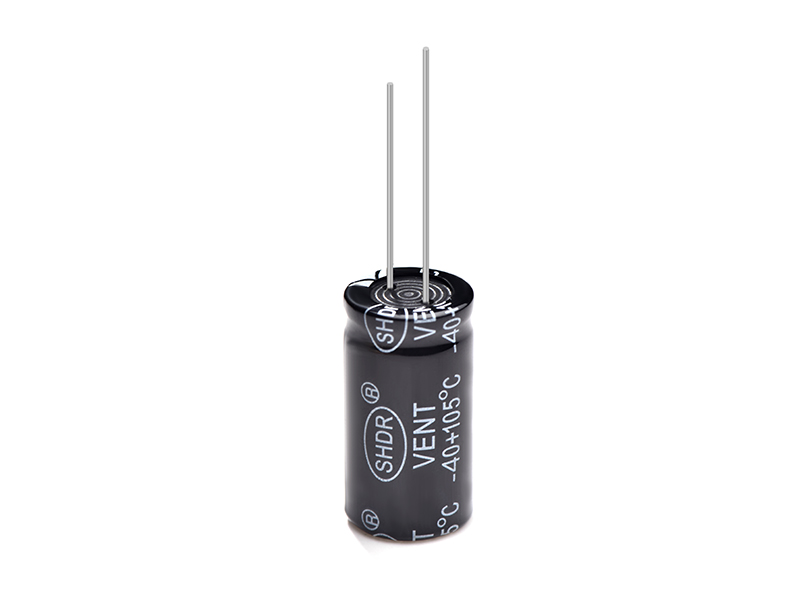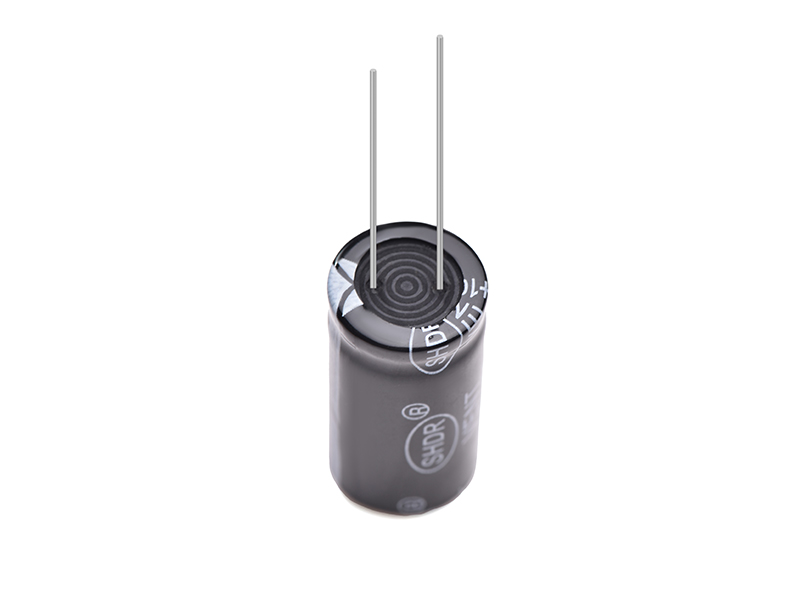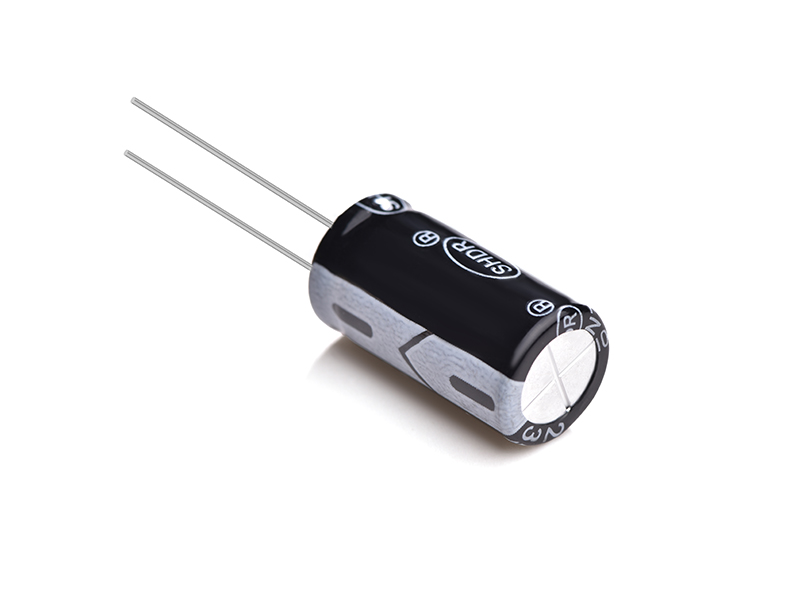2200uf 35v Capacitor
SHDR® Application Notes
Designing Device Circuits
1. Select the capacitors to suit installation and operating conditions,
and use the capacitors to meet the performance limits prescribed in
this catalog or the product specifications.
2. Polarity
Aluminum Electrolytic Capacitors are polarized.
Apply neither reverse voltage nor AC voltage to polarized capacitors.
Using reversed polarity causes a short circuit or venting. Before use,
refer to the catalog, product specifications or capacitor body to identify
the polarity marking. (The shape of rubber seal does not represent the
directional rule for polarity.) Use a bi-polar type of non-solid aluminum
electrolytic capacitor for a circuit where the polarity is occasionally
reversed. However, note that even a bi-polar aluminum electrolytic
capacitor must not be used for AC voltage applications.
3. Operating voltage
Do not apply a DC voltage which exceeds the full rated voltage. The
peak voltage of a superimposed AC voltage (ripple voltage) on the DC
voltage must not exceed the full rated voltage.
A surge voltage value, which exceeds the full rated voltage, is prescribed
in the catalogs, but it is a restricted condition, for especially short periods
of time.
4. Ripple current
The rated ripple current has been specified at a certain ripple frequency.
The rated ripple current at several frequencies must be calculated by
multiplying the rated ripple current at the original frequency using the
frequency multipliers for each product series.
5. Category temperature
The use of a capacitor outside the maximum rated category temperature
will considerably shorten the life or cause the capacitor to vent.
The relation between the lifetime of aluminum electrolytic capacitors and
ambient temperature follows Arrhenius' rule that the lifetime is
approximately halved with each 10°C rise in ambient temperature.
6. Life expectancy
Select the capacitors to meet the service life of a device.
7. Charge and discharge
Do not use capacitors in circuits where heavy charge and discharge
cycles are frequently repeated. Frequent and sharp heavy discharging
cycles will result in decreasing capacitance and damage to the capacitors
due to generated heat. Specified capacitors can be designed to enduring
such a condition. Rapid charging/discharging may be repeated in a circuit
where the ripple voltage at the two terminals of the aluminum electrolytic
capacitor fluctuates greatly. If the variation range of voltage exceeds
70Vp-p, please consult us.
8. Failure modes of capacitors
Non-solid aluminum electrolytic capacitors, in general, have a lifetime
which ends in an open circuit, the period is dependent upon temperature.
Consequently, lifetime of capacitors can be extended by reducing the
ambient temperature and/or ripple current.
9. Insulation
a) Electrically isolate the following parts of the capacitor from the negative pole
terminals, positive terminals and circuit traces.
• Cases for non-solid aluminum electrolytic capacitors.
• Dummy terminals for non-solid aluminum electrolytic capacitors,
This is designed for installation stability.
b) The casing of the capacitor is not guaranteed to be an insulator (except
for screw type). For applications requiring an insulating outer layer
sleeve, custom designed capacitors are recommended.
10. Conditions
Do not use/exposed capacitors under the following conditions.
a) Oil, water, brine. Avoid storing in damp places.
b) Direct sunlight.
c) Toxic gases such as hydrogen sulfide, sulfurous acid, nitrous acid, chlorine or its compounds, and ammonium.
d) Ozone, UV or radiation.
e) Severe vibration or mechanical shock conditions beyond the limit
specified in the catalog or product specification.
11. Installation
a) Electrolytic paper and electrolytic conductive electrolyte
Non-solid aluminum electrolytic capacitors are flammable. leakage
Electrolyte on printed circuit boards can gradually corrode copper
traces, which may cause smoking or burning through a short circuit
copper traces.
Verify the following points when designing the PC board.
• Provide proper hole spacing on PC board to match
Terminal spacing of capacitors.
• Leave the following open space above the vent so that the vent can
Proper operation.
Case Diameter Clearance
Ø6.3 to Ø16mm minimum 2mm
Ø18 to Ø35mm minimum 3mm
Ø40mm or more 5mm minimum
• Do not place any wires or copper traces on the device's vents.
capacitor.
• Installing a capacitor with a vent facing the PC board requires a
There are proper ventilation holes on the PC board.
• Do not run any copper traces under the capacitor seal.
The traces must go through 1 or 2mm to one side of the capacitor.
• Avoid placing any hot objects near
capacitors, even on the reverse side of the PC board.
• Do not pass anything through holes or under capacitors.
• When designing double-sided printed circuit boards, do not place any copper
Trace the sealed side of the next capacitor.
b) Do not install the terminal side of the screw-mounted capacitor downward.
If the screw terminal capacitor is mounted on its side, make sure
Positive is higher than negative.
Do not fasten the terminal screws and mounting clips to the
Product Picture




Copyright © Guangzhou Shenghe Electronic Technology Co., Ltd. All Rights Reserved Sitemap | Powered by
